Creating interest in your business, your brand, the opportunities on offer, and the open roles and positions you need to fill, is an important part of your recruitment process.
Engaging with candidates builds trust and relationships. With many organizations receiving thousands of applications for each role, the old methods of staying in touch are no longer viable, but that doesn't mean you can't keep your candidates engaged.
In this article, we explore what it takes to create strong candidate engagement, how you can use new technologies to make life easier on yourself, and the attributes your candidates expect from you.
What is candidate engagement?
Candidate engagement is the ongoing process of building meaningful connections with job seekers throughout the recruitment journey.
This includes:
- Proactive communication
- Providing clear and timely updates
- Creating a positive, transparent experience for candidates at every stage of hiring
Unlike candidate experience, which focuses on how applicants feel about the recruitment process, candidate engagement emphasizes maintaining interest, trust, and interaction with potential hires—even beyond the application stage.
Effective candidate engagement ensures candidates feel valued, informed, and aligned with the company’s culture and goals. This process is vital in attracting top talent, reducing drop-off rates, and fostering a strong employer brand. By prioritizing candidate engagement, companies can create a talent pipeline that drives long-term recruitment success.
Why is candidate engagement important?
Candidate engagement plays a crucial role in attracting, securing, and retaining top talent in a competitive job market. Here’s why it’s important for modern recruitment strategies:
Enhances employer branding
Engaged candidates have a positive view of your company. This ultimately strengthens your employer brand, making it more appealing to top talent. A strong brand reputation, in turn, leads to better-quality referrals and positions your company as a desirable place to work.
Reduces candidate drop-off rates
Candidates often disengage during the hiring process due to poor communication or lengthy application forms. Effective engagement keeps them informed and motivated, reducing the chances of them abandoning the process or accepting another offer.
As such, a smooth and engaging recruitment experience can significantly decrease drop-off rates and help companies avoid missing out on top-tier talent due to poor internal hiring processes.
Improves hiring outcomes
Engaged candidates are more likely to remain invested throughout the recruitment process. This increases the likelihood of finding and hiring the right fit for your organization. When candidates feel valued, they’re more inclined to perform well in interviews and transition smoothly into their roles.
Fosters long-term relationships
Candidate engagement extends beyond filling a single role. By maintaining strong connections with candidates who weren’t selected, you create a high-quality talent pool to mine for future opportunities.
Engaged candidates are also more likely to recommend your organization to others, further improving your employer brand and giving you a new pipeline of high-quality candidates.
In short, by prioritizing candidate engagement, companies can drive better recruitment results and establish themselves as employers of choice.
Common barriers to candidate engagement
Despite the importance of candidate engagement, many organizations face challenges that hinder their ability to build meaningful connections with job seekers. Addressing these barriers is key to improving recruitment outcomes.
Here are the most common challenges with building candidate engagement:
- Lack of timely communication. One of the biggest frustrations for candidates is feeling left in the dark. Delayed responses or long periods of silence during the recruitment process can lead to disengagement and negative impressions of your organization.
- Overly lengthy application processes. Complex or time-consuming application forms can deter candidates from completing the process, and put them off from applying to your company again. A streamlined, user-friendly application experience is essential to maintaining candidate interest.
- Generic and impersonal interactions. Candidates want to feel valued and seen as individuals, not just numbers. Automated emails without personalization or a lack of tailored responses can make applicants feel undervalued—especially late in the hiring process.
- Prolonged hiring timelines. Extended hiring processes often cause candidates to lose interest, especially when they’re actively exploring other opportunities. This is made worse when there are long periods of silence between milestones. Top talent is typically off the market within a few weeks, making efficiency and regular communication crucial.
- Unclear expectations or process details. When candidates don’t know what to expect they may feel uncertain and disengage. Transparency around things like interview timelines, stages, or role requirements is vital to keep candidates informed and engaged.
- Insufficient feedback. Candidates value constructive feedback, even when they’re not selected. Without it, they may feel their time was wasted and develop negative perceptions of your company. This is particularly important when candidates dedicate a significant amount of time and go through multiple rounds of interviews and assessments. A lack of feedback can leave them feeling used or undervalued, which can result in negative sentiment being shared online about your company.
- Failing to leverage technology. Outdated systems or a lack of automation can slow down processes and create inconsistent communication, leading to poor engagement. Modern tools like applicant tracking systems (ATS), recruitment automation tools, and AI chatbots can bridge those gaps to ensure consistent and timely communication throughout the hiring process.
By recognizing and addressing these barriers, organizations can create a smoother, more engaging candidate experience that attracts and retains top talent.
Who’s involved in candidate engagement?
Strong candidate engagement requires collaboration across multiple roles within an organization. Each player brings unique contributions to ensure a seamless and positive experience for job seekers.
Here are the key players in candidate engagement and their responsibilities.
Recruiters
Recruiters are the front-line communicators throughout the hiring process. They are responsible for sourcing talent, maintaining regular communication, and guiding them through the hiring process. Recruiters set the tone for how candidates perceive the company, making it critical for them to be proactive, responsive, and transparent.
Hiring managers
Hiring managers play a crucial role in evaluating candidates and representing the team they will potentially join. They provide insights into the role, team dynamics, and expectations, helping candidates better understand the opportunity.
Engaged hiring managers can build trust with candidates and demonstrate the organization’s commitment to hiring the best fit.
HR professionals
Human resources professionals oversee the broader candidate engagement strategy. They implement tools like applicant tracking systems, streamline communication processes, and ensure compliance with organizational policies.
HR also monitors metrics like candidate satisfaction and engagement rates to identify areas for improvement.
Marketing and employer branding teams
Marketing teams contribute by creating a strong employer brand that attracts and excites candidates. They produce content that highlights company culture, values, and employee success stories, ensuring candidates feel a connection with the company before applying.
Leadership and executives
Executives shape the overall vision and culture of the organization. Their involvement in candidate engagement—through outreach, interviews, or public messaging—demonstrates the company’s investment in its people and can help attract top-tier talent.
By working together, these players create a cohesive engagement strategy that supports a positive candidate journey and strengthens the company’s ability to attract high-quality talent.
How to measure candidate engagement: key metrics
Measuring candidate engagement is essential for evaluating the effectiveness of your recruitment strategies and identifying areas of improvement.
By tracking specific metrics and using the right tools, you can gain valuable insights into how candidates interact with your organization throughout the hiring process. Let’s explore key candidate engagement metrics to follow, how to calculate and benchmark engagement rates, and key tools from which to pull data.
Key candidate engagement metrics to track
To gauge candidate engagement, focus on the following metrics:
- Application completion rate. The percentage of candidates who complete the application process after starting it. A low rate may indicate a lengthy or complicated process.
- Response rate. The percentage of candidates who respond to communication, such as interview invitations or follow-up emails.
- Time to apply. The average time it takes candidates to complete an application. Faster times suggest a more streamlined process.
- Email open and click rates. Track how often candidates open recruitment emails and click on links, such as job descriptions or application portals.
- Interview attendance rate. The percentage of candidates who show up for scheduled interviews, reflecting their interest and engagement level.
- Offer acceptance rate. The proportion of candidates who accept your job offers, indicating their enthusiasm for your company and the role.
- Candidate Net Promoter Score (NPS). Measure how likely candidates are to recommend your company based on their experience during the hiring process.
In addition to these metrics, you can also consider tracking engagement on career sites, job postings, and social media posts that share open roles or information about workplace culture. Consult with your marketing team about the best way to track these metrics to gain an understanding of how—and how frequently—prospects are engaging with your recruitment marketing material before applications are submitted.
Tip: Recruitee by Tellent allows you to create custom data dashboards to track key metrics related to your application process, open jobs, and overall candidate engagement.
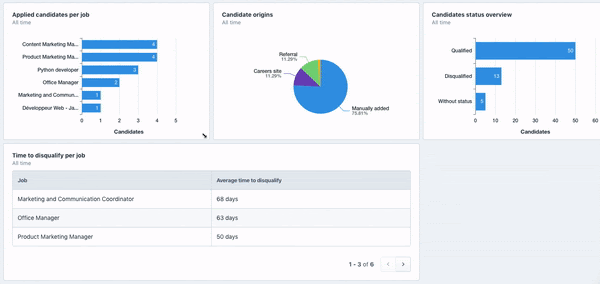
How to calculate candidate engagement rates
Once you’ve established the candidate engagement metrics you want to track, the next step in the process is to benchmark engagement rates. This gives you a starting point from which to improve your candidate engagement efforts.
To calculate engagement rates, divide the number of candidates who take a specific action by the total number of candidates reached.
For example, to calculate response rates, use this formula:
(Number of responses / Total number of candidates contacted) x 100.
Use similar calculations for metrics like application completion or email click-through rates. In all cases, you’ll want to have the total number of applicants in the pool and the total number of desired actions taken. A simple division between these two numbers will give you a raw engagement rate that you can use to inform future actions.
By monitoring these metrics and using the right tools, you can create data-driven strategies to improve candidate engagement and enhance the overall hiring process.
10 tips for improving candidate engagement
Boosting candidate engagement requires intentional strategies tailored to each stage of the hiring process. Below are ten actionable tips to help you build meaningful connections with candidates and ensure a positive experience.
1. Personalize communication
Candidates want to feel like more than just a name in an ATS.
Personalizing your interactions with candidates shows you value them as individuals. Use their name in emails, reference specific details from their resume, and tailor messaging to the role they’re applying for.
For example, “We noticed your extensive project management experience and believe it’s a great match for this role” leaves a stronger impression than a generic and template reply. A small effort in personalization can go a long way toward building trust.
Tip: Recruitee by Tellent offers a variety of ways to communicate with candidates, ranging from 1:1 outreach to automated email updates to SMS communication. Craft your communication strategy and send direct messages to candidates, all within the Recruitee platform.

2. Share a hiring timeline and stick to it
Clarity and reliability in your hiring timeline can make or break a candidate’s experience. Be clear and transparent from the beginning about how long the process will take, and what will be expected from the candidate.
Start by outlining your hiring process from start to finish—when applications close, interview schedules, and final decision dates. For instance, letting candidates know that “Interviews will take place between March 1 and March 15” helps them plan accordingly.
If delays occur, communicate promptly with an update. Candidates are more likely to remain engaged when they feel the process is well-structured and predictable.
3. Create an efficient application process
An overly complex application process can deter even the most qualified candidates. Keep the process short and relevant, only asking the most important information from your candidates.
For example, instead of requiring lengthy cover letters, ask a few targeted questions about the candidate’s qualifications and motivations. Simplifying the process not only increases application rates but also leaves candidates with a positive impression of your organization.
Tip: With Recruitee by Tellent, you create tailored application forms for each job opening. This allows you to ask only the most relevant and important questions—including knockout questions—that will help you effectively screen candidates.
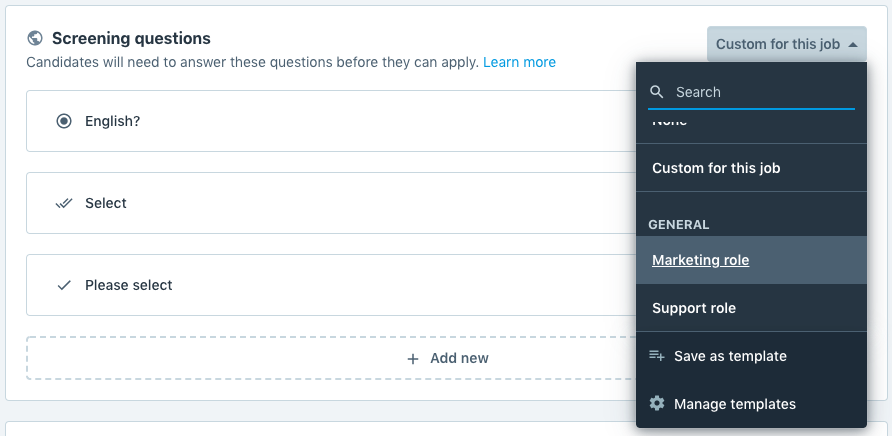
4. Provide timeline updates
Candidates often feel ghosted when they don’t hear back after applying or interviewing.
Avoid this by sending regular updates, even if it’s to say, “We’re still reviewing applications.” A tool like Recruitee by Tallent can automate these communications, ensuring candidates are never left wondering about their status.
For example, an email like “You’ve been shortlisted for the next stage—stay tuned for an interview invite!” reassures candidates and keeps them engaged.
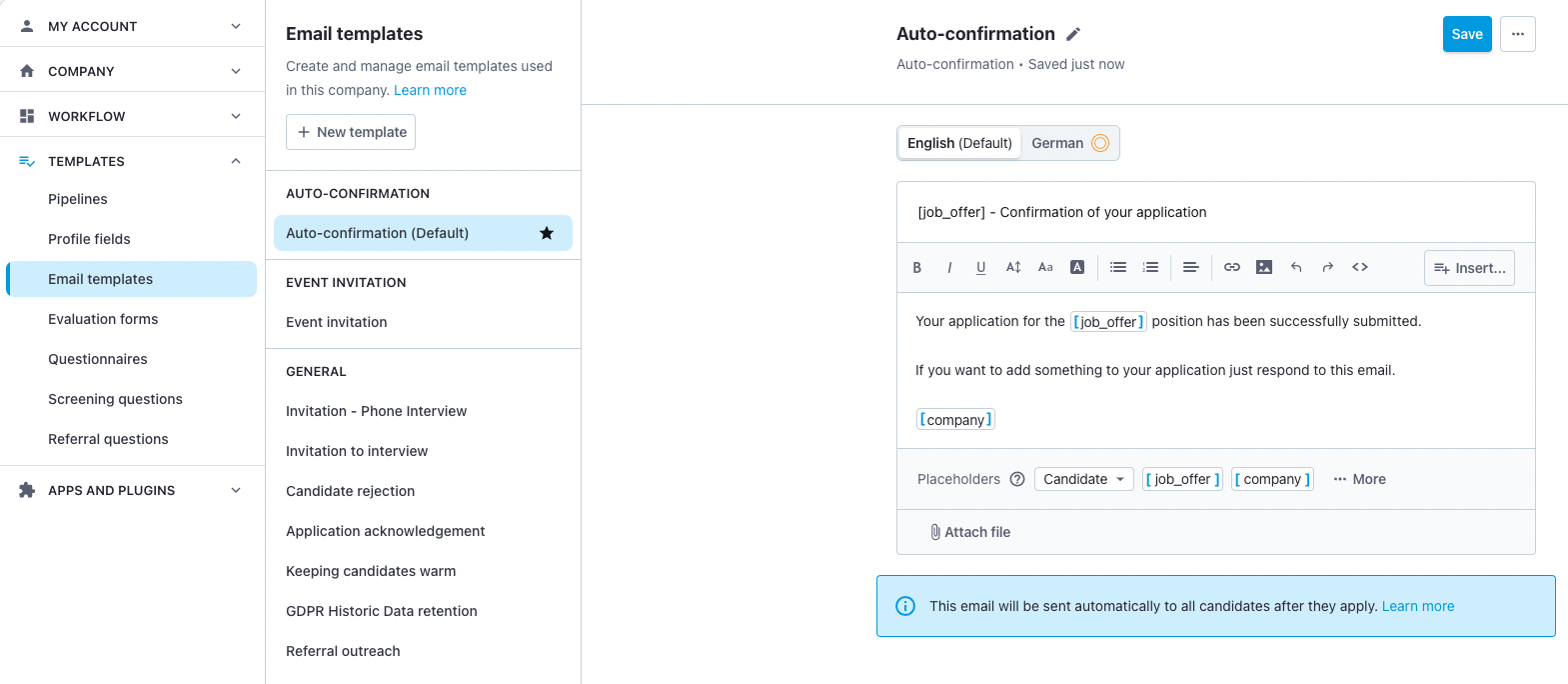
5. Showcase your employer brand
Your employer brand is your opportunity to stand out in a crowded job market. Use your careers site and social media channels to showcase employee testimonials, highlight company values, and share photos of team events.
A strong employer brand not only attracts talent but also builds excitement about joining your organization. For example, featuring a “Meet Our Team” series on Instagram can humanize your brand and draw interest from passive candidates.
Tip: Easily build and customize your career site with Recruitee’s CareersHub tool. This allows you to create and customize careers sites using existing templates, or through entirely customized builds. Track engagement on your careers site pages with Recruitee’s advanced analytics and dashboards.
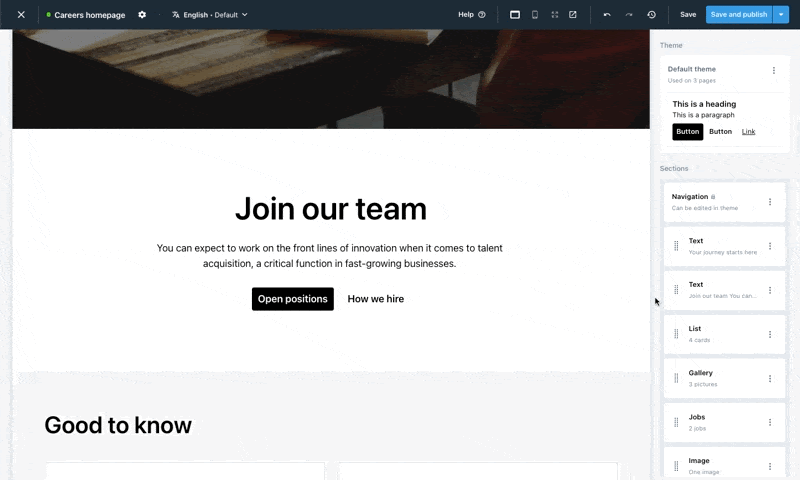
6. Use technology to drive engagement
Technology is your ally in managing candidate engagement efficiently.
AI Chatbots, for example, can answer FAQs, ensuring that candidates can receive an answer to their questions at all times ofthe day. CRM tools, likewise, can send personalized updates at scale to keep candidates updated throughout the process.
For example, a chatbot integrated into your careers page can provide instant responses to common queries like “What benefits do you offer?” or “What’s the status of my application?” These tools not only save time but also keep candidates informed and satisfied.
Tip: Recruitee by Tellent offers a third-party integration with Joboti, a messaging tool that builds smart recruitment chatbots. By configuring customized workflows within Joboti, recruiters can use this tool to answer FAQs, and communicate with candidates through tools like WhatsApp.
7. Set clear expectations
Transparency is key to maintaining candidate trust. Whether it’s explaining the structure of the interview or detailing the expected timeline for a decision, clarity reduces anxiety.
For example, letting candidates know, “Our next step is a 45-minute technical interview followed by a team discussion” ensures they’re prepared and confident. The more clear and upfront you are, the better the candidate’s experience.
Tip: At Tellent, we use a standard email template to send preparatory emails to each candidate before an interview to help. This is a great tool for engaging with candidates in advance of an interview, and ensuring that they come prepared and ready to chat.
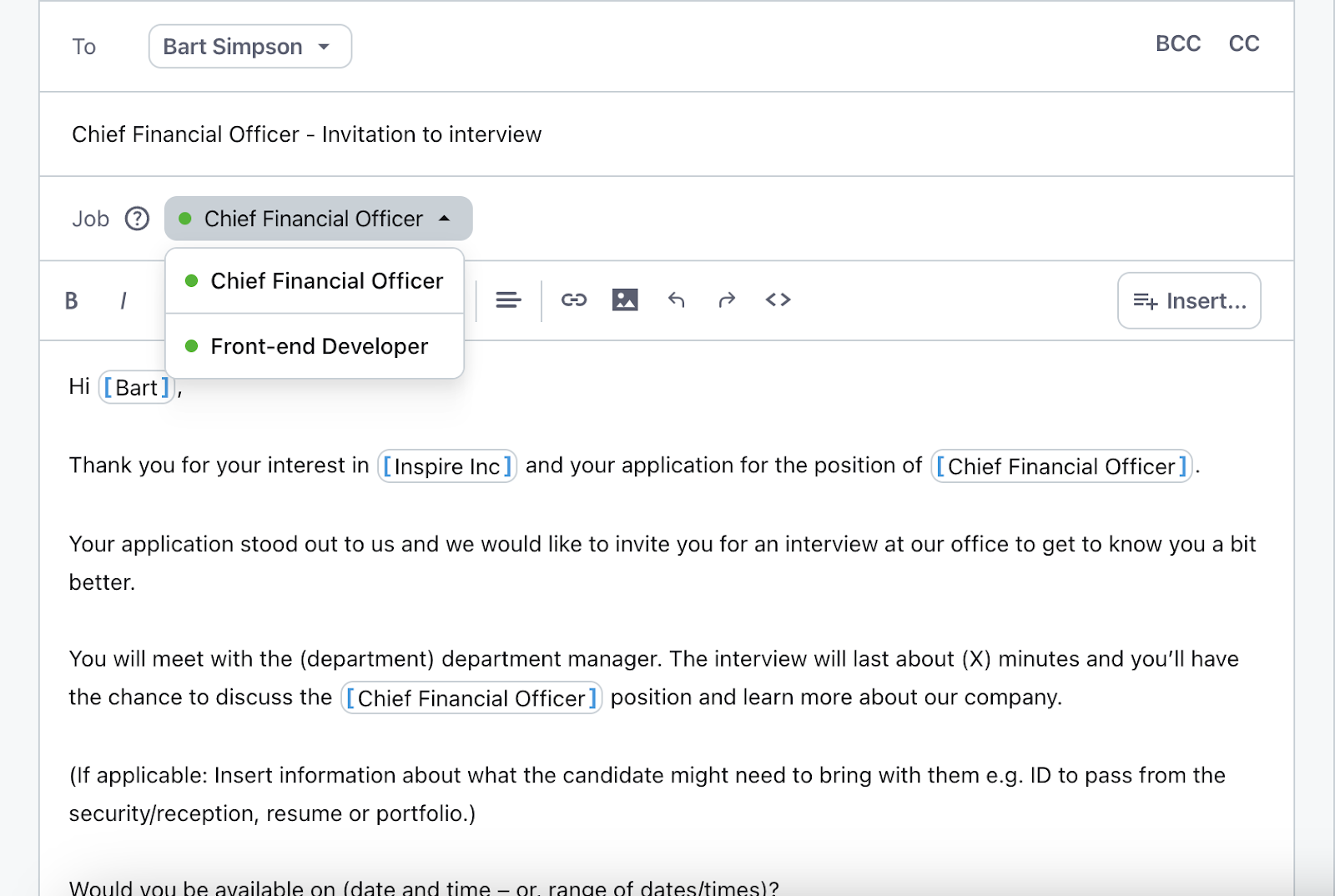
8. Offer feedback after interviews
Constructive feedback is invaluable to candidates, even if they aren’t selected. While it might not be feasible to provide detailed feedback to every applicant, aim to share specific notes with those who reach advanced stages.
For example, a quick call or email saying, “Your presentation skills were excellent, but we’re seeking someone with more leadership experience” helps candidates improve and leaves a positive impression of your organization.
9. Engage passive candidates
Passive candidates are a goldmine for future hires. Stay on their radar by sharing industry insights, hosting webinars, or even inviting them to casual networking events.
For instance, a quarterly newsletter featuring company updates and job openings can nurture relationships with high-potential candidates. Over time, these efforts can convert passive talent into active applicants.
10. Incorporate gamification
Gamification adds a creative twist to the hiring process and keeps candidates engaged. This can range from role-specific assessments to fun challenges, such as a coding competition for software developers or a creative brief for marketing applicants. For example, hosting a virtual escape room that mirrors your company’s values and goals can be both engaging and informative. Candidates enjoy showcasing their skills in unique ways, and it gives you insights into their fit for the role.
Building a winning candidate engagement strategy
Creating an effective candidate engagement strategy requires a structured approach that aligns with your company’s hiring goals and values. Here are the key steps to crafting a winning strategy:
- Define your goals. Start by identifying what you want to achieve with candidate engagement. Whether it’s reducing drop-off rates, improving application completion, or attracting passive candidates, clear goals help shape your strategy.
- Understand your audience. Know your target candidates. What motivates them? What are their pain points? Use surveys, focus groups, or data from past recruitment cycles to gather insights into their needs and expectations.
- Map the candidate journey. Outline every touchpoint candidates have with your organization, from discovering a job posting to receiving an offer. Identify opportunities to engage and address gaps in communication or experience.
- Leverage technology. Invest in tools like applicant tracking systems (ATS), chatbots, and CRM platforms to streamline communication and personalize interactions at scale.
- Incorporate employer branding. Highlight your company culture and values through social media, careers pages, and employee testimonials to attract candidates who align with your vision.
- Set measurable metrics. Track engagement metrics such as response rates, application completion rates, and Net Promoter Scores to evaluate the effectiveness of your efforts.
- Iterate and improve. Use candidate feedback and data analytics to refine your strategy. Continuous improvement ensures you stay competitive and responsive to candidate expectations.
A comprehensive strategy will not only enhance the candidate experience but also strengthen your reputation as an employer of choice. By prioritizing engagement at every stage of the hiring process, you can attract top talent and build a more effective hiring pipeline.
Make candidate engagement a priority in your organization
Hiring in vast numbers is tough to get right. Candidate engagement can be the first thing to suffer, and associatively, so will your business.
Remember, your candidates aren't just numbers in a huge list—they're people. If you set up a system that you'd be happy with as an applicant, you're going to get somewhere fairly close. Show your candidates respect and take care of them as much as possible, even when that means finding the best ways for your technology to deliver your actions for you.
Keeping candidates interested in your company, your culture, and every new possibility you offer could mean picking up an existing application for a brand new role instead of starting the whole process from step one, time and time again.








